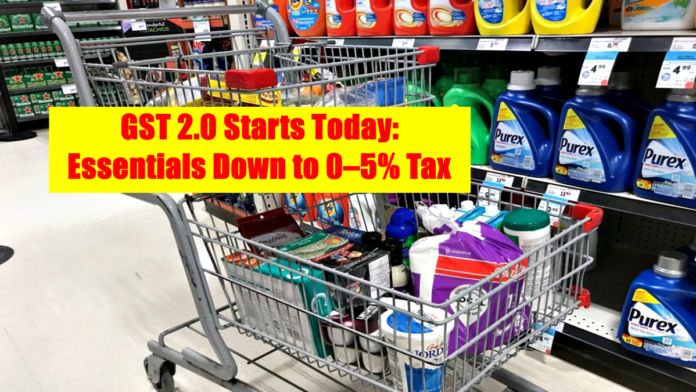
Key Points
- GST 2.0 takes effect nationwide on 22 September 2025, the first day of Navratri.
- Four slabs are merged into 5% and 18%, with a special 40% rate for “sin” and luxury goods.
- Over 99% of items previously in the 12% slab move to 5%.
- UHT milk, cheese, bread, ready-to-eat roti / paratha now attract 0% GST.
- Life and health insurance plus 33 life-saving drugs are fully exempt.
- Small cars, appliances, cement shift from 28% to 18%, lowering prices.
- Luxury cars, motorcycles > 350 cc, tobacco and caffeinated drinks face the new 40% sin tax.
New Delhi: GST 2.0 came into force at midnight, 22 September 2025, ushering in the most sweeping tax overhaul since 2017. The reform aligns with the government’s promise to simplify indirect taxes and boost consumption during the festive season.
A Simpler Two-Slab Structure
The GST Council has collapsed the earlier 5%, 12%, 18% and 28% brackets into just two core rates 5% for mass-use items and 18% for most others while introducing a 40% levy on goods deemed harmful or ultra-luxurious. Policymakers say this will remove inverted-duty anomalies, speed up refunds and make compliance easier for small businesses.
Essentials Now at 0% or 5%
Most kitchen staples have moved into the lowest bracket or gone tax-free. Packaged dairy such as UHT milk and cheese, bakery items like bread, khakhra, roti and paratha, and education supplies pencils, erasers, notebooks, maps and globes now bear zero GST. The exemption list also covers 33 critical medicines, including three oncology drugs, and all personal life and health insurance policies.
Electronics, Cement and Small Vehicles Cheaper
Consumer-durable giants have already announced price cuts of 8–10% on air-conditioners, refrigerators and washing machines after the rate on white goods fell from 28% to 18%. Builders can expect lower project costs as cement also drops to 18%. In the auto sector, hatchbacks and motorcycles under 350 cc shift to the same 18% slab, reducing showroom prices by an estimated ₹18,000–₹35,000, depending on model.
The New 40% ‘Sin’ Bracket
To offset revenue losses, the government has hiked taxes on items it calls “sin goods.” Cigarettes, gutkha, caffeinated drinks, casinos, betting services, high-end SUVs and motorcycles over 350 cc now face a 40% GST. Industry analysts predict premium two-wheeler prices could climb by up to ₹70,000, while large SUVs may see on-road costs rise 12–14%.
Expected Household Savings
Finance Ministry officials estimate that, for a four-member urban family, the combined effect of lower grocery and utility bills could free up ₹2,500–₹3,000 per month for discretionary spending, potentially accelerating festive sales. Economists project the reforms could add 0.4 percentage points to GDP growth in FY 2025-26 if businesses pass on the full benefit.
Digital Compliance and Faster Refunds
Beyond rate cuts, GST 2.0 introduces pre-filled returns, a single refund window and a risk-based audit system designed to cut filing time by 25% for MSMEs. The Council expects these steps to widen the tax base while improving cash flow for exporters.
By slashing rates on everyday necessities and tightening levies on luxury and harmful goods, GST 2.0 aims to put more money in consumers’ hands just as the festive shopping season begins. Whether companies pass on the full benefit and how states cope with potential short-term revenue gaps will determine the long-term success of India’s bold new tax chapter.












































